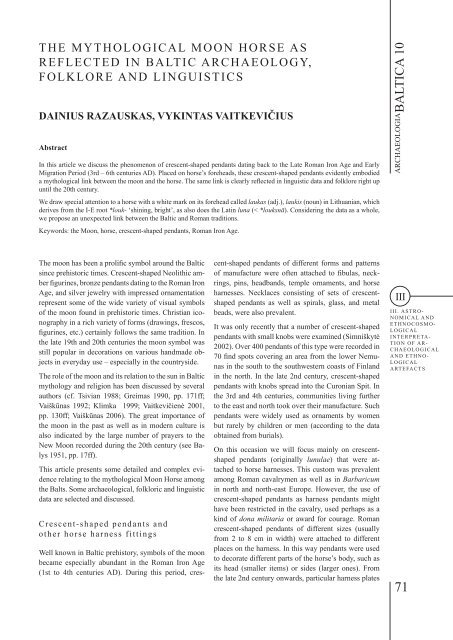BALTICA10
BALTICA10
BALTICA10
You also want an ePaper? Increase the reach of your titles
YUMPU automatically turns print PDFs into web optimized ePapers that Google loves.
The Mythological Moon Horse as<br />
Reflected in Baltic Archaeology,<br />
Folklore and Linguistics<br />
DAINIUS RAZAUSKAS, VYKINTAS VAITKEVIČIUS<br />
Abstract<br />
In this article we discuss the phenomenon of crescent-shaped pendants dating back to the Late Roman Iron Age and Early<br />
Migration Period (3rd – 6th centuries AD). Placed on horse’s foreheads, these crescent-shaped pendants evidently embodied<br />
a mythological link between the moon and the horse. The same link is clearly reflected in linguistic data and folklore right up<br />
until the 20th century.<br />
We draw special attention to a horse with a white mark on its forehead called laukas (adj.), laukis (noun) in Lithuanian, which<br />
derives from the I-E root *louk- ‘shining, bright’, as also does the Latin luna (< *louksnā). Considering the data as a whole,<br />
we propose an unexpected link between the Baltic and Roman traditions.<br />
Keywords: the Moon, horse, crescent-shaped pendants, Roman Iron Age.<br />
ARCHAEOLOGIA BALTICA 10<br />
The moon has been a prolific symbol around the Baltic<br />
since prehistoric times. Crescent-shaped Neolithic amber<br />
figurines, bronze pendants dating to the Roman Iron<br />
Age, and silver jewelry with impressed ornamentation<br />
represent some of the wide variety of visual symbols<br />
of the moon found in prehistoric times. Christian iconography<br />
in a rich variety of forms (drawings, frescos,<br />
figurines, etc.) certainly follows the same tradition. In<br />
the late 19th and 20th centuries the moon symbol was<br />
still popular in decorations on various handmade objects<br />
in everyday use – especially in the countryside.<br />
The role of the moon and its relation to the sun in Baltic<br />
mythology and religion has been discussed by several<br />
authors (cf. Tsivian 1988; Greimas 1990, pp. 171ff;<br />
Vaiškūnas 1992; Klimka 1999; Vaitkevičienė 2001,<br />
pp. 130ff; Vaiškūnas 2006). The great importance of<br />
the moon in the past as well as in modern culture is<br />
also indicated by the large number of prayers to the<br />
New Moon recorded during the 20th century (see Balys<br />
1951, pp. 17ff).<br />
This article presents some detailed and complex evidence<br />
relating to the mythological Moon Horse among<br />
the Balts. Some archaeological, folkloric and linguistic<br />
data are selected and discussed.<br />
Crescent-shaped pendants and<br />
other horse harness fittings<br />
Well known in Baltic prehistory, symbols of the moon<br />
became especially abundant in the Roman Iron Age<br />
(1st to 4th centuries AD). During this period, crescent-shaped<br />
pendants of different forms and patterns<br />
of manufacture were often attached to fibulas, neckrings,<br />
pins, headbands, temple ornaments, and horse<br />
harnesses. Necklaces consisting of sets of crescentshaped<br />
pendants as well as spirals, glass, and metal<br />
beads, were also prevalent.<br />
It was only recently that a number of crescent-shaped<br />
pendants with small knobs were examined (Simniškytė<br />
2002). Over 400 pendants of this type were recorded in<br />
70 find spots covering an area from the lower Nemunas<br />
in the south to the southwestern coasts of Finland<br />
in the north. In the late 2nd century, crescent-shaped<br />
pendants with knobs spread into the Curonian Spit. In<br />
the 3rd and 4th centuries, communities living further<br />
to the east and north took over their manufacture. Such<br />
pendants were widely used as ornaments by women<br />
but rarely by children or men (according to the data<br />
obtained from burials).<br />
On this occasion we will focus mainly on crescentshaped<br />
pendants (originally lunulae) that were attached<br />
to horse harnesses. This custom was prevalent<br />
among Roman cavalrymen as well as in Barbaricum<br />
in north and north-east Europe. However, the use of<br />
crescent-shaped pendants as harness pendants might<br />
have been restricted in the cavalry, used perhaps as a<br />
kind of dona militaria or award for courage. Roman<br />
crescent-shaped pendants of different sizes (usually<br />
from 2 to 8 cm in width) were attached to different<br />
places on the harness. In this way pendants were used<br />
to decorate different parts of the horse’s body, such as<br />
its head (smaller items) or sides (larger ones). From<br />
the late 2nd century onwards, particular harness plates<br />
III<br />
III. ASTRO-<br />
NOMICAL AND<br />
ETHNOCOSMO-<br />
LOGICAL<br />
INTERPRETA-<br />
TION OF AR-<br />
CHAEOLOGICAL<br />
AND ETHNO-<br />
LOGICAL<br />
ARTEFACTS<br />
71
















